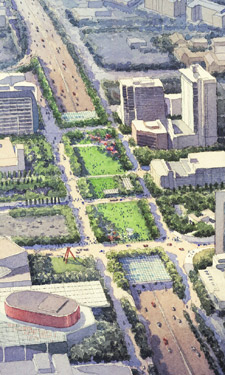 In many cities, the only thing that runs over a freeway is an overpass, a utilitarian expanse of concrete and steel where the only human interactions are fender benders and blaring horns. In Dallas, Texas, however, residents can now enjoy Klyde Warren Park, a 5.2-acre elevated deck park built right over Woodall Rodgers Freeway. The urban green space connects the city’s Arts District and downtown with its exciting uptown area, and engaging features including a dog park, a children’s play area, walking trails, a performance pavilion, daily free programming, and more have already drawn tens of thousands of visitors since the park’s grand opening in October 2012.
In many cities, the only thing that runs over a freeway is an overpass, a utilitarian expanse of concrete and steel where the only human interactions are fender benders and blaring horns. In Dallas, Texas, however, residents can now enjoy Klyde Warren Park, a 5.2-acre elevated deck park built right over Woodall Rodgers Freeway. The urban green space connects the city’s Arts District and downtown with its exciting uptown area, and engaging features including a dog park, a children’s play area, walking trails, a performance pavilion, daily free programming, and more have already drawn tens of thousands of visitors since the park’s grand opening in October 2012.
Named after the young son of one of the park’s biggest benefactors, the idea for the park emerged in 2002 when real estate agent John Zogg began gathering support for the project. By 2004, Zogg and other organizers had founded the Woodall Rodgers Park Foundation, and contributions continued to stream in. About half of the project’s $110 million cost came from city bond, state highway, and stimulus funds, with the remaining balance coming in from individual donors.
As the plan for the park called for it to be built as a floating structure atop a major downtown artery, organizers recognized they would need highly experienced architects and urban planners to bring the dream to reality. Dan Biederman, the urban manager who revolutionized Manhattan’s Bryant Park in the early 1990s, served as a consultant on the project. His company, Biederman Redevelopment Ventures, helped develop schematic programming design and staffing plans; made revenue, governance, and management recommendations; helped raise the last round of funds; and proposed revenue-generating plans for future park operations. The structure itself, designed by award-winning landscape architect Jim Burnett and Jacobs Engineering Group, is supported by more than 300 concrete beams, spaced to form large trenches for 322 trees planted in a special soil mix that helps keep it from being too heavy. It’s easily accessible by car, bike, or public transit.
“The key to creating vibrant urban parks is to fill them with programming that attracts people who live, work, and visit nearby,” Biederman says. That certainly has been a success so far in Klyde Warren Park, which boasts a full daily schedule of events free to the public, including yoga, fitness classes, chess games, music and dance performances, film screenings, knitting circles, ballroom dance classes, and more.
As a factor of his father’s $10 million donation, quiet fourth grader Klyde Warren will be at least partly responsible for his namesake park’s future maintenance. But for now, he simply enjoys playing in the park along with the rest of the city and reveling in the dream come true a decade in the making.
Danielle Taylor is Associate Editor of Parks & Recreation.

